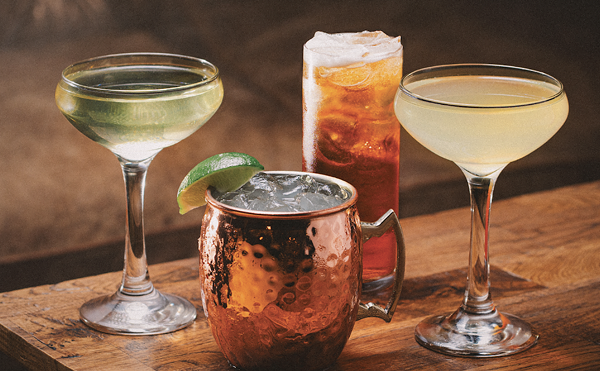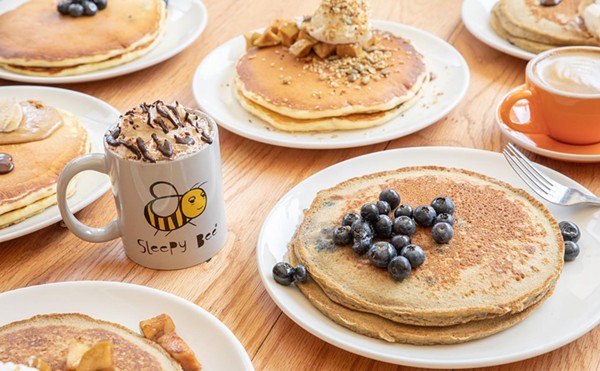|
Stretching across the plump rumpled belly of Middle England, from Nottingham in the east Midlands, sweeping through Hereford and Worcestershire to the south and continuing westward to the border of Wales, is a geographical region known quite implausibly as the Pork Pie Belt.
Here, across this wide band of greenery, the traditional British pork pie is a food staple. A solid pie filled with a mixture of pork, herbs and spices surrounded by a protective layer of pork jelly and then encased in a satisfying hot water crust, the pork pie has been produced in this region since the 14th century. It is a perfect example of traditional English food: hearty, comforting and unnecessarily maligned by people who haven't been raised on it.
I was produced in the Pork Pie Belt too, in Birmingham — which sits at the buckle of the straining belt as it cuts through the Midlands and on to Wales. In my own lifetime, I have probably eaten several thousand pork pies, straining my own belt buckle in the process.
Since leaving England for the United States more than 10 years ago, my pork pie consumption has dwindled precipitiously and is now limited to my semi-annual visits home. And so it was only a matter of time before I attempted to make my own pork pies.
Carefully, I began searching for recipes, gathering together the handful that seemed the simplest to complete. I bought my ingredients: 2 1/2 pounds of pork shoulder, some bacon, two pig's feet, all-purpose flour, butter, eggs, an onion, a carrot, nutmeg, mace and allspice.
I harvested some fresh sage leaves from my window box. And I thought, mostly, about pies.
· · ·
All pork pies are not created equal. In Ripponden, England, nestled in the damp hills of West Yorkshire, the members of the Pork Pie Appreciation Society (PPAS) meet weekly to celebrate that fact. The PPAS Web site states: "Every week, a different member now brings in 16 pies from a new source in the official pie-fetcher's box — an old tea tin. His pies are judged by the members and marks are awarded for appearance, cross-section and taste, and the final tally registered in the Society ledger."
In March 2005, PPAS founding member Stuart Booth and his wife Joanne would have needed a very large pie-fetcher's box for their three-tiered pork pie wedding cake, which was the subject of a Times of London news story. The 50-pound pie was the first three-tiered wedding pork pie that butcher and piemaker Simon Haigh had ever been asked to make.
"We've never heard of one before," he said earnestly, "certainly not a three-tier."
The PPAS meeting ledger is archived online in all of its egg-brushed and gently-browned glory. Through it, we can revisit pie-tastings past.
For instance, on Saturday afternoon, July 9, 2005, the pie-tasters gathered to taste a pie that had been brought by the appointed pie-fetcher from nearby Cullingworth. To give the weekly meetings historical perspective, the Web site has a world news section, and the two most important global events to occur in the week of the meeting were the bombing of London by Islamic terrorists (who, incidentally, would not have eaten pork pies) and the death of Luther Vandross, aged 54 (who probably ate more than his fair share). The Cullingworth pie was rated from 1 to 10 by the seven club members present, including John, who was impressed — "Well glazed, enjoyed pastry, moist, fresh, not mass produced: 8.0" — and the pie-fetcher, who seemed to harbor some lingering resentment over driving to Cullingworth to pick up the pies — "Too full, bland, in car for two hours: 7.5."
· · ·
Back in the kitchen, I add two scrubbed pink pig's feet, an onion, a carrot and a couple of generous pinches each of whole peppercorns and cloves to a large pan of water and bring the mixture to a full boil. Reducing the heat, I simmer the pot's contents for another three hours, filling the kitchen with an aromatic nimbus of steam. Then I strain the cloudy stock through a fine sieve into a clean pan, boil it further to reduce its volume to about a half-liter and leave it to set into an opaque jelly.
I cut almost 3 pounds of de-boned pork shoulder and three slices of lean bacon into centimeter-sized pieces and then add chopped sage, mace, nutmeg, allspice and anchovy essence to the pink mound of meat. Mixing it thoroughly by hand, I place it in the refrigerator and begin making the pastry.
Working quickly, I roll my pastry out into a flat sheet and shape it around a jar of jelly wrapped in greaseproof paper. After removing the jar, I spoon my meat filling into the pie shell, compacting it with the back of the spoon to fill the pastry completely. I make a pastry lid, cut a small, circular hole in it, place it carefully on top of my pie and brush its entire surface with a beaten egg and place my pie in the oven at 400 degrees Fahrenheit. I cross my fingers, and I think of pies.
· · ·
The first recorded example of a pork pie recipe appeared in the medieval cookbook The Forme of Cury — A Roll of Ancient English Cookery, Compiled About A.D. 1390 by the Master-Cooks of King Richard II.
Whether medieval chefs wanted to make a Payn Puff (page 89), a Formenty on a Fischsday (page 121) or a Balourgly Broth (page 122), the instructions outlining precisely how to do so were contained within this collection of 205 ancient recipes. While the medieval vocabulary might require a little attention — for instance, Conynggyes in Gravey (page 94), "Schul by sodyn and hakkyd in gobbettys" — the recipe for a pork and cheese pie (page 192) from 1390 looks remarkably similar to the one I have just followed today.
Sure, chefs are instructed to take their pork, "pyke it clene; grynde in smal," and then add a generous dose of "gode powdours" — but essentially, the rest of the recipe looks almost identical.
· · ·
Peering into the oven, I can see clear juices bubbling around the base of my pie. I can smell the gode powdours infusing the meat inside the pastry. Once browned, I pull it from the oven and leave it to cool for a couple of hours.
I reheat my jelly, watching it turn from a solid back into a viscous liquid, pour it into a Ziploc bag, snip one corner off, and use it as a spout. I slowly pour the contents of the bag into the hole in the lid of my cooked pork pie. Inside, the jelly is filling the spaces between the meat and the pastry where it will set overnight.
An hour or two later, I can no longer resist. I take my pie — it feels heavy, like a brick wrapped in pastry — and I cut it in half. I assess its appearance, as would any self-respecting member of the Pork Pie Appreciation Society.
And then I taste it. All day, I have been thinking about pies and the Pork Pie Belt, and now, with one mouthful, I am home. ©





